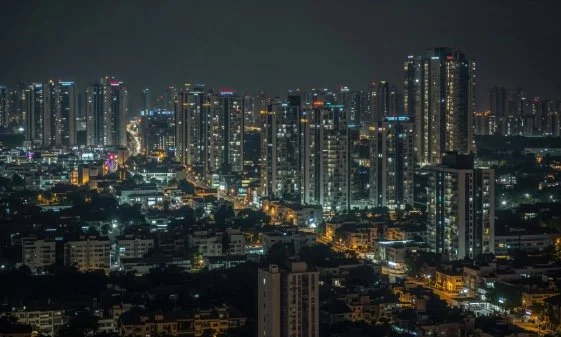Ground is Sinking Under Millions of Homes in Indian Cities: Study
8-Year Satellite Study Shows Slow But Serious Ground Shifts Under Megacities
October 29, 2025
A new study offers a serious warning for India’s rapidly expanding urban areas, presenting evidence that large parts of five megacities, including Delhi, Mumbai, Chennai, Kolkata and Bengaluru, are sinking due to the over-extraction of groundwater. This subsidence is causing uneven ground deformation, which in turn is putting thousands of buildings at growing risk of long-term structural damage.
Published in Nature Sustainability, a peer-reviewed scientific journal, the study used eight years of satellite radar images (from 2015 to 2023) to track how the ground is moving in five major Indian cities. By scanning nearly 13 million buildings, scientists created detailed maps showing where land is sinking or rising. They used a technology called InSAR, which can measure ground changes as small as a few millimetres.
Pulling out too much groundwater causes the layers of soil and rock underground to get squeezed, which makes the land above slowly sink. Although you can’t see it happening, this sinking can warp the ground under buildings. Over time, this weakens their foundations and underground pipes, increasing the chance of cracks, damage or collapse, especially in areas that also face floods, earthquakes or have poorly built structures.
Delhi is sinking more than all the other cities that were part of the study, with areas like Faridabad, Bijwasan and Ghaziabad sinking as much as 51 millimetres each year. In contrast, parts of Dwarka are rising slightly because, over the past 10 years, there have been efforts to refill underground water, collect rainwater and restore old water bodies.
Chennai has widespread and worrying subsidence in the city centre and around the Adyar River’s floodplain. Neighbourhoods such as Tondiarpet and K.K. Nagar are particularly affected, with land sinking more than 38 millimetres per year. The ground in this area is made up of sandy clay and silt, which easily gets compressed when water is removed from below.
Mumbai appears more stable overall, but vulnerable areas are concentrated in low-income, high-density settlements like Dharavi, where unregulated borewells and crowded infrastructure amplify the risks.
Kolkata shows relatively mild subsidence patterns, but still significant enough to place over 30,000 buildings in projected future risk zones. The affected areas are built on soil layers that were formed thousands of years ago during the Pleistocene and Holocene periods in Earth’s history, which makes them more likely to sink when groundwater is pumped out.
Bengaluru shows the least subsidence due to its underlying rock formations, which are harder and less compressible. Still, there was a noted spike in groundwater use in late 2022, suggesting that risks could rise if extraction increases.
The researchers looked at how uneven sinking of the ground in small patches, called differential settlement, affects buildings. This kind of uneven movement bends parts of a building slightly, creating stress in walls and foundations. Over time, this stress can lead to cracks, faster damage and a higher risk to the building’s safety.
At present, over 2,400 buildings across Delhi, Mumbai and Chennai are already in the high-damage-risk category. That number could exceed 20,000 within 50 years, depending on how subsidence trends continue.
Future risk scenarios were projected across three timeframes: 10, 30 and 50 years. In the far-future scenario, Chennai will likely have the most buildings exposed to moderate or high damage risk, surpassing even Delhi and Mumbai. Bengaluru and Kolkata remain in the low-risk zone for now, but this could change with groundwater overuse.
The study implies that residents in rapidly urbanising or already dense zones, particularly in Delhi, Chennai and Mumbai, are living in areas where invisible land deformation may be silently weakening the ground beneath their homes. People in poorer neighbourhoods are particularly exposed, as informal settlements often rely on unregulated water sources, lack structural resilience and are already marginalised from urban planning protections.
For infrastructure, the implications are serious. Roads, bridges, pipelines, drainage networks and even metros could be undermined by slow but continuous land sinking. Public safety and investment in infrastructure are both at stake. Damage risk will be worsened by climate events like floods or heatwaves, and failure to factor land subsidence into planning decisions will increase vulnerability.
The study lays out five urgent actions Indian cities must take.
First, the country needs a national system to monitor land sinking using satellite technology like InSAR, which tracks small ground movements with high accuracy. These maps should guide every stage of construction, from planning to maintenance. Second, cities must control how much groundwater is pumped out. This includes stricter rules on borewells, promoting rainwater harvesting, and recycling used water. Delhi’s Dwarka area shows that such steps can help reverse the damage.
Third, building rules need an urgent upgrade. At present, they don’t consider risks from sinking land or uneven ground movement. New buildings, especially in high-risk areas, must be designed with this in mind. Fourth, every city has different soil and rock conditions, so urban planning must be tailored to local geology. Poorer neighbourhoods in weak soil zones should be given top priority for safety improvements. Fifth, subsidence should be treated as part of a larger problem that includes climate change, poor construction, water shortage and floods. Cities must recharge groundwater, protect surface water and restore green spaces to make themselves more resilient.
You have just read a News Briefing by Newsreel Asia, written to cut through the noise and present a single story for the day that matters to you. Certain briefings, based on media reports, seek to keep readers informed about events across India, others offer a perspective rooted in humanitarian concerns and some provide our own exclusive reporting. We encourage you to read the News Briefing each day. Our objective is to help you become not just an informed citizen, but an engaged and responsible one.

